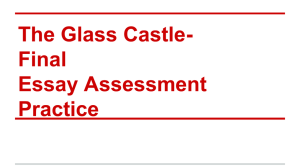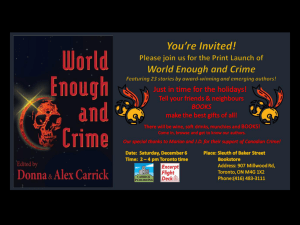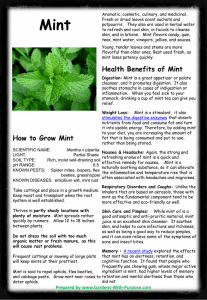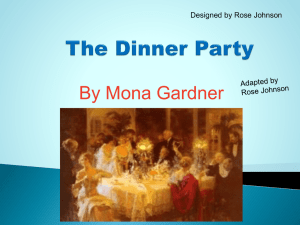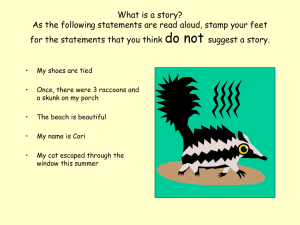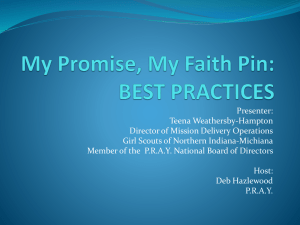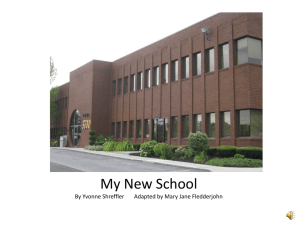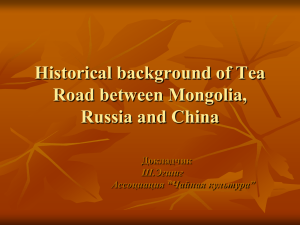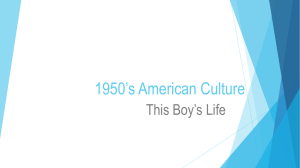PPT 2
advertisement
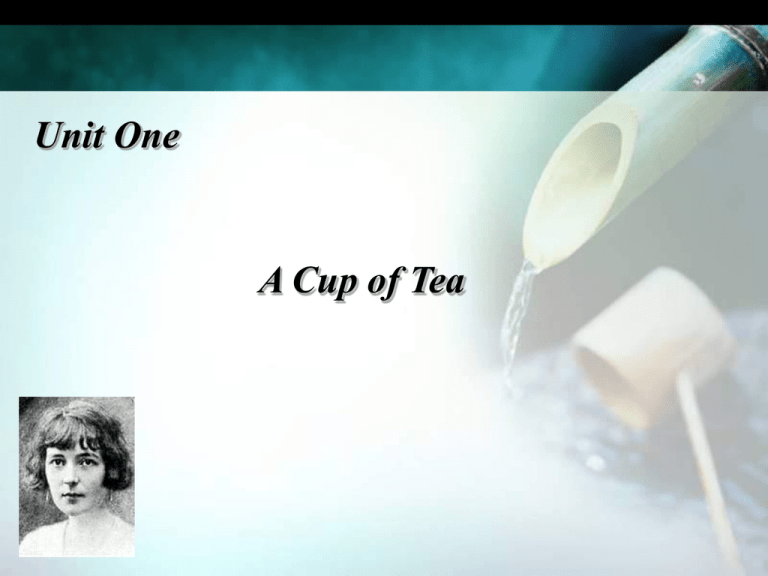
Unit One A Cup of Tea A Short Story: A Cup of Tea A Cup of Tea is a 1922 short story by Katherine Mansfield. It was first published in the Story-Teller in May 1922. It later appeared in The Dove's Nest and Other Stories. Literary Elements Setting (背景) Character (人物) Plot (情节) Point of view (视角) Theme (主题) Style (风格) Symbolism (象征) a. Setting of the story A Cup of Tea is set in England at the beginning of the twentieth century. At this time, people from different social classes did not socialize with one another, and it was considered improper for upper-class women to work inside or outside the home. (The socio-economic characteristics of the location) b. Characters in A Cup of Tea Rosemary Fell, a rich woman the antiquarian on Curzon Street Miss Smith, the poor girl picked up and fed by Rosemary Jeanne, a housemaid Philip, Rosemary’s husband What kind of person is Rosemary? a. Snobbish (buying flowers) b. Vain (She couldn’t help noticing the charm of her hands against the blue velvet, while she was shopping in the antique shop.) c. Romantic: she was always lost in the world of dreams, fantasy and romanticism. (taking a beggar home) d. Rosemary was an impulsive woman. She didn’t think before she acted. She did prove this when she took the beggar-girl home without thinking of the reaction of her husband and other servants at her house. e. Jealous:( send the girl away) c. Point of view used in the story Omniscient Point of View Limited Omniscient For limited omniscient, the narrator tells the story in the third person, but stays inside the confines of what is perceived, thought, remembered and felt by a single character (or at most by very few characters) within the story. In A Cup of Tea, all the events and actions are presented as they unfold before, and filter to, the reader through the particular perceptions, awareness, and responses of only one character, Rosemary. (1) And her husband absolutely adored her. (2) They were rich, really rich, not just comfortably well off, (3) which is odious and stuffy and sounds like one’s grandparents. (4) But if Rosemary wanted to shop she would go to Paris as you and I would go to Bond Street. (1)她丈夫对她是绝对地爱慕; (2)他们家可阔了, 名副其实地阔,可不仅仅是日子过得宽裕舒服地 那种阔; (3)那听上去简直像哪家的老头老太太一 样又讨厌又乏味; (4)罗斯玛丽想买东西时就去巴 黎,对她来说,就像你我去证券街买东西一样, 是家常便饭。 Analysis: Sentences (1)& (3) adopt the limited omniscient and sentences (2) & (4) use the omniscient point of view. d. Theme: This is the message about life from the author to the reader. It is like a lesson for life, something you can learn from the story and apply to other life situations. Q1. What can you see of Rosemary’s character from the first paragraph of the text? Original text: Rosemary Fell was not exactly beautiful. No, you couldn’t have called her beautiful……. She was young, brilliant, extremely modern, exquisitely well dressed, amazingly well read in the newest of the new books, and her parties were the most delicious mixture of the really important people and…artists—quaint creatures, discoveries of hers, some of them too terrifying for words, but others quite presentable and amusing. 罗斯玛丽不见得怎么美。不,她称不上美。漂亮吗?唉,要 是把她五官拆开来看的话……不过干吗这么狠心,竟要把人 家五官拆开来呢?她年轻漂亮,特别讲究衣着,时髦极了。 说来也怪,最新出版的书她本本都看过。跟她来往的人凑在 一块儿倒也十分有趣,有真正的头面人物,也有……艺术家 ---这些个怪物都是她物色来的,有几位说不出多吓人,可 其他几位倒很体面,也很风趣。 Q2. What do the exhibits, the conduct of the attendant, his language and appearance join to create the atmosphere of the antique shop? ……. He beamed whenever she came in. He clasped his hands; he was so gratified that he could scarcely speak. Flattery, of course. All the same, there was something…… 只要她一进门他总是满脸笑容,十指交叉,高兴得几乎连 话也说不出来。巴结自不待说。反正真有意思…… P3. “You see, Madam,” he would explain in his low respectful tones, “I love my things. I would rather not part with them than sell them to someone who does not appreciate them, who has not that fine feeling which is so rare…” “您瞧,夫人,”他总是用谦卑而恭敬的口气解释说,“ 我把货当成宝贝,要我把货卖给那些不识货的人,卖给那 些没真正眼力的人,那我宁可不脱手,有眼力的可实在难 得啊……” P3. But the shopman had already bowed as though keeping it for her was all any human being could ask. He would be willing, of course, to keep it for her for ever. 谁知掌柜的早已低头哈腰,仿佛替她留着这个小玩意儿真 是无上荣幸。这还用说,他当然愿意替她保留着,永远替 她保留都行。 The discreet door shut with a click…… 谨慎的店门咔嗒一声关上了。 P4. Q3. What are some of the reasons for Rosemary to take the girl home? ……How more than extraordinary! And suddenly it seemed to Rosemary such an adventure. It was like something out of a novel by Dostoevsky, this meeting in the dusk. Supposing she took the girl home? Supposing she did one of those she was always reading about or seeing on the stage, what would happen? It would be thrilling. 其实何止是奇怪!忽然间在罗斯玛丽看起来这成了次奇遇。黄 昏的邂逅就像陀思妥耶夫斯基一篇小说里的情节一样。她把姑 娘带回家去怎么样?她真的做出她常常在书里读到,或在舞台 上看到的那类事,那又会怎么样呢?这一定够带劲的。 P4. And she heard herself saying afterwards to the amazement of her friends: “I simply took her home with me”…… 她听见自己事后对那些不胜诧异的朋友们说:“我就这样 把她带回家来了。” P4. She was going to prove to this girl that—wonderful things did happen in life, that—fairy godmothers were real, that—rich people had hearts, and that women were sisters. 她还打算向这姑娘证明,生活中确实有怪事,神话 里的好心仙女确实是有的,有钱人也有好心肠,女 人家都是姐妹等等。 Q4. Why does Rosemary let the girl go? How do you understand Rosemary’s question to her husband, the question whether she was pretty? Suppose you were Rosemary, what would you do? “She’s absolutely lovely. Look again, my child. I was bowled over when I came into your room just now. However … I think you’re making a ghastly mistake. Sorry, darling, if I’m crude and all that. But let me know if Miss Smith is going to dine with us…….” 她确实长得可爱。你再去看看,宝贝儿。我刚进你房间就 看的傻了眼。话又说来…我想你这下可大错特错了。宝贝 儿,要是我说话粗鲁和有什么不到的地方,请别见怪。不 过你待会儿得趁早告诉我一声,史密斯小姐是否和咱们一 起用晚饭… Pretty! Absolutely lovely! Bowled over! Her heart beat like a heavy bell. Pretty! Lovely! 漂亮!确实可爱!看的傻了眼!她的心怦怦直跳,像口 大钟在敲。漂亮!可爱! d. Major themes of the story class consciousness feminism materialism shallowness jealousy greed for ownership of possessions class consciousness Why couldn’t the couple keep the girl at their home? Feminism: Patriarchy: the male oppression of women Analysis: 'I say,' said Philip, when they were alone. 'Explain. Who is she? What does it all mean?' Rosemary, laughing, leaned against the door and said: 'I picked her up in Curzon Street. Really. She's a real pick-up. She asked me for the price of a cup of tea, and I brought her home with me.' 'But what on earth are you going to do with her?' cried Philip. 'Be nice to her,' said Rosemary quickly. 'Be frightfully nice to her. Look after her. I don't know how. We haven't talked yet. But show her--treat her--make her--feel--' 'My darling girl,' said Philip, 'you're quite mad, you know. It simply can't be done.' e. Style: A New Kind of Short Story Mansfield is credited with writing a new kind of short story – one more concerned with the emotions and psychological makeup of its characters than those of the past. Through the use of images, dialogues, monologue, and metaphors, Mansfield focuses on her characters’ emotional states, subtle shifts of mood and epiphanies(顿悟) – that is, their sudden, significant realizations. f. Symbolism A symbol represents an idea, quality, or concept larger than itself. E.g. The box that Rosemary admires and the salesperson would rather not allow to fall into the hands of the mindless rabble is a perfect symbol of the consumerist mentality. The box, like the girl, is pretty, but other than that it possesses little in the way of utilitarian necessity for Rosemary. An exquisite little enamel box with a glaze so fine it looked as though it had been baked in cream. On the lid a minute creature stood under a flowery tree, and a more minute creature still had her arms round his neck. Rosemary’s dependence on her husband Title: a cup of tea Girl → Rosemary Rosemary → Philip g. Plot Plot is the organized pattern or sequence of events that make up a story. Every plot is made up of a series of incidents that are related to one another. Plot Structure 3 2 1 4 5 1). Exposition (introduction) This usually occurs at the beginning of a short story. Here the characters are introduced. We also learn about the setting of the story. Most importantly, we are introduced to the main conflict (main problem). 2). Rising Action This part of the story begins to develop the conflict(s). A building of interest or suspense occurs. 3). Climax This is the turning point of the story. Usually the main character comes face to face with a conflict. The main character will change in some way. 4). Falling Action All loose ends of the plot are tied up. The conflict(s) and climax are taken care of. 5). Resolution (conclusion) The story comes to a reasonable ending. It’s your turn to…… identify these parts in our story: A Cup of Tea. 1). Exposition From the beginning of the story to the moment when a poor girl stops Rosemary for the price of a cup of tea. 2). Rising Action Instead of offering the poor girl money, Rosemary brings her home and plans to take care of her. 3). Climax Philip tells Rosemary that Miss Smith is very attractive (actually it is a tactic because he doesn’t agree to keep Miss Smith at their home). 4). Falling Action Rosemary gives Miss Smith 3 pound notes and let her go. 5). Resolution Rosemary asks her husband, “Am I pretty?” Additional introduction to plot A sequence of events, causally related; What happens in the story. Plot Arrangement Chronological 1st event happens first, etc Flashback Past events are experienced as a memory In media res The story begins in the middle of the action Foreshadowing Suggesting, indicating, hinting or showing what will happen later in a story …… What is Conflict? A clash between opposing forces, usually forcing the main character into a dilemma. Conflict is the dramatic struggle between two forces in a story. Without conflict, there is no plot. Types of Conflict Character vs Character Character vs Nature Character vs Society Character vs Self Character vs. Character Conflict This type of conflict finds the main character in conflict with another character, human or not human. Character vs. Nature Conflict This type of conflict finds the main character in conflict with the forces of nature, which serve as the antagonist. Jane leaves Thornfield and sleeps outside. Character vs. Society Conflict This type of conflict has the main character in conflict with a larger group: a community, society, culture, etc. “I’m tired of living in a hole,” said Jenny. “Let’s fight for freedom!” cried Bouncer. “We’ll be soldiers! Rough-riding Rowdies! I’ll be the general and commanderin-chief!” The Island of the Skog by Steven Kellogg Character vs. Self Conflict In this type of conflict, the main character experiences some kind of inner conflict. Finally, Sam’s father said, “Go to bed now. But before you go to sleep, Sam, tell yourself the difference between REAL and MOONSHINE.” Sam, Bangs & Moonshine by Evaline Ness Please identify different kinds of conflict in our story and find out evidences to support them. Character vs. Character Conflict Rosemary vs. Philip Rosemary vs. Miss Smith Character vs. Society Conflict Miss Smith vs. society Rosemary vs. society Character vs. Self Conflict Rosemary’s inner struggle (keep the girl or not?) Further reading http://en.wikipedia.org/wiki/Katherine_Mansfield http://en.wikipedia.org/wiki/A_Cup_of_Tea http://www.kirjasto.sci.fi/kmansfi.htm http://www.quotationspage.com/quotes/Katherine_M ansfield/ http://www.katherinemansfieldsociety.org/ Thanks!

